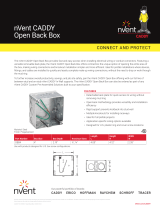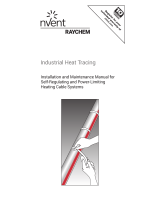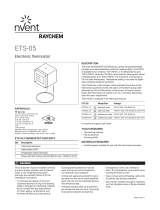Page is loading ...

RAYCHEM Heating System
Tank Heater Installation Instructions
DESCRIPTION
nVent RAYCHEM Heating System (RHS) tank heaters are
designed for applications ranging from freeze protection to
process maintenance of tanks. The RHS-H heaters have a defined
application parameter for use only on unlined metal tanks with
fluid maintain temperatures not to exceed 200°F. The RHS-L
heaters have a broader application range for use on polypropylene,
fiber-reinforced plastic (FRP), or for both lined and unlined metal
tanks with fluid maintain temperatures not to exceed 120°F.
RHS heaters must be used in conjunction with a primary control
thermostat. RHS heaters have an integrated thermostat which
must be used only for over-temperature protection in the event
of failure of the primary thermostat. These instructions describe
the procedure for installation of RHS tank heaters. Storage and
handling instructions are also provided. Carefully follow all
directions.
RHS heaters come with a factory-supplied, liquid-tight conduit
and fitting to transition heater cold-lead wires into the conduit.
The cold lead wires are 14 AWG copper conductors with Teflon
insulation.
For technical assistance, contact nVent at (800)545-6258.
ADDITIONAL MATERIALS REQUIRED
• RAYCHEM RHS Installation Kit (P/N 844869)
• RAYCHEM thermostat or equivalent
• RAYCHEM BCK-35 clamp kit (P/N C77215) or equivalent
• Thomas and Betts 5232 conduit fitting and 5302 sealing ring or
agency approved equivalent
The RHS heater must be installed correctly to
ensure proper operation and to prevent shock or
fire. Read these important warnings and carefully
follow all the installation instructions.
• To minimize the danger of fire if the heater is
damaged or improperly installed, and to comply
with nVent requirements, agency certifications,
and national electrical codes, ground-fault
equipment protection must be used on each
heater branch circuit.
• Damaged heaters and connections must be
replaced. Do not attempt to repair or energize if
damaged.
• Approvals and performance are based on the
use of specified parts only. Do not use substitute
parts or vinyl electrical tape.
• Leave these installation instructions with the
user for future reference.
Uncured adhesive can irritate eyes. Read warnings
on tube. Consult MSDS VEN0004 for additional
information.
WARNING:
CAUTION:
APPROVALS
Class I, Div. 2, Groups B, C, D
Class II, Div. 1 & 2, Groups E, F, G
Class III
All hazardous location applications must be
engineered by nVent.
T-ratings:
Low-watt heaters: T4A
High-watt heaters (Class I): T2C
High-watt heaters (Class II & III): Contact nVent
Ordinary and Hazardous Locations
-G

2 | nVent.com
RHS storage
1. Keep each heater in its box until you are ready to install it.
2. Store the box in a cool, dry environment.
3. Avoid stacking heavy objects on the box, which could damage
the RHS heater.
Handling
IMPORTANT: This heater is an electrical device. Handle it with the
same care you would use with any electrical device and carefully
follow these instructions.
1. In the field, keep the heater in its box until you are ready to
install it on the tank.
2. To avoid mechanical damage, do not lay the heater where it
can be stepped on or struck by tools or equipment.
3. Do not fold or twist the heater, or allow it to be bent smaller
than the 17-inch minimum bend radius.
Tank preparation
1. Inspect the tank surface. The installation area must be free of
• Sharp protrusions (weld splatter, rough seams, etc.)
• Rust and corrosion
• Grease, oil, moisture
• Obstructions, such as instrument lines, electrical wiring or
conduit, tank support, or reinforcements.
2. File, sand, or sandblast the tank surface as required to provide
a smooth, rust-free paintable mounting area large enough
for the heater you are using plus 3 inches beyond the heater
outline. For polypropylene or fiber-reinforced plastic (FRP)
tanks, use 60-grit sandpaper to roughen the tank surface,
going a minimum of 3 inches beyond the heater outline.
3. The tank surface must be free of grease, oil, and moisture.
4. The tank surface and the RHS heater must be clean and dry until
adhesive has fully cured.
Preparation
1. Perform an insulation resistance megohmmeter (Megger) test
on the heater immediately after removing the heater from the
shipping carton. Instructions on how to perform the Megger
test are in the “Testing and Maintenance” section.
2. Using an ohmmeter, measure the heater resistance using the
white and black cold leads. If the resistance is greater than
450 ohms, call your nVent representative.
3. Install the tank heater below the typical minimum fluid level.
If this level is unknown, install heater on the lower 1⁄3 of the
tank. This will ensure proper heat to the liquid.
4. Do not attach the flexible conduit to the heater at this time, as
the weight will make the installation to the tank more difficult.
5. Before proceeding with the installation, make sure that you
have sufficient RHS Installation Kits (P/N844869). Note: RHS-
H-500 and RHS-L-150 heaters will each require approximately
one adhesive tube; RHS-H-1000 and RHS-L-300 heaters will
each require approximately one and one half tubes; RHS-H-
1400 and RHS-L-420 heaters will each require two tubes.
6. Hold the RHS heater against the tank and, using a marking
pen, outline the heater perimeter.
7. The tank surface must be prepared as stated under “Tank
preparation” on the previous page and be free of grease,
oil, and moisture. The tank surface temperature should be
between 0°F (–18°C) and 150°F (65°C) for proper installation.
Heater preparation
8. Place the heater on a flat surface with the metal ground plate
facing up. Using the aluminum
tape included with the mounting
kit, place two strips along both
vertical ends. Half the tape
should overlap the heater’s edge
and the ends of tape should
extend 3 inches beyond the heater.
9. Place two more strips of
aluminum tape horizontally
across the heater, one inch in
from the heater’s edge.
10. Turn the heater over so that the
red silicone rubber surface is facing up. Wipe the silicone
surface with a soft cloth to remove any dirt or debris.
11. Unscrew the cap from the adhesive tube. Cut off the end of
the adhesive tube at the first thread. Cut one inch off the cap
and screw it back on the tube. Note: The adhesive working
time is approximately 10 minutes. Application and spreading
of the adhesive must be done quickly, without interruptions.
Do not attempt to install the heater if the adhesive is tack free
to the touch. Partially cured, tack free adhesive will inhibit
adhesion and thermal transfer to the tank, which can lead to
heater damage. Note
health warnings on
adhesive tube.
12. Apply the adhesive only
on the red silicone rubber
portion of the heater. The
adhesive bead should be
approximately 1/4 in in
diameter and spaced
approximately 1/2 in apart
placed in a serpentine pattern
across the width of the heater.
13. Using the straight edge of the trowel, distribute the adhesive
evenly on the red silicone
rubber portion of the heater.
Fill in voids or gaps with
additional adhesive. Once
smoothed, the adhesive
thickness should be no more
than 1/16 in thick.

nVent.com | 3
Heater installation on tank
IMPORTANT: The tank heater must be installed with good contact to
the tank wall. Inadequate contact, excessive adhesive, or voids in the
adhesive may result in lower tank heater efficiency.
14. Holding the heater by the terminal box and the opposite end,
place the heater on the prepared tank surface. While still
holding the terminal box, use
the wedge to smooth the
aluminum tape to the tank
surface. Remove all ripples
from the tape to ensure it will
hold securely.
15. Using the wedge, starting from the center of the heater and
working out to the perimeter,
ensure you spread the
adhesive evenly and remove
any trapped air.
16. Place three more vertical strips of aluminum tape on the
heater. The first strip should be located next to the terminal
box. The second strip should be placed 6 inches in from the
opposite end. The third strip
should be placed at the
heater centerline. Use the
wedge to smooth the
aluminum tape.
17. The adhesive must be allowed 24 hours to fully cure before
you install the flexible conduit and thermal insulation. After
24 hours, the two exposed horizontal edges must be sealed
with aluminum tape. This will prevent contaminants from
getting under the heater. The
tape should extend
approximately 1.5 inches
beyond the edges of the
heater.
Flexible conduit installation
1. After the adhesive has been allowed to cure for 24 hours and
the heater horizontal edges sealed with aluminum tape, you may
attach the flexible conduit. A 4-foot length of flexible conduit is
provided with the heater.
2. Measure the distance between the heater terminal box and
power junction box. Use standard industry practice to cut
conduit to appropriate length.
3. Connect the conduit to the power junction box first. Use a
Thomas and Betts 5232 conduit fitting and 5302 sealing ring
(or agency approved equivalent) to keep the enclosure water-
tight and dust-tight.
4. Connect the conduit to the heater terminal box. Make sure the
blue nylon bushing is seated on the heater terminal box fitting.
Place one wrench on the hexagonal nut located on the heater
terminal box. This nut must not rotate during installation.
Hand tighten the cap nut and then use a second wrench to
completely tighten. The fitting manufacturer recommends
25foot pounds of torque to be applied.
5. Fully insulate tank. Place identification labels on insulation,
showing the location of the heater beneath.
Thermostat installation and connection
1. Install and connect the primary thermostat(s) as shown in
the thermostat installation instructions. The wiring diagrams
provided on the next page are for reference only.
2. Install the primary thermostat bulb midway between two
RHS heaters or heater and heat sink at the same level as the
heaters. The bulb should be placed horizontally around the
tank using a RAYCHEM BCK-35 (P/NC77215) clamp kit or
equivalent.
3. Connect the primary thermostat(s) and heater cold leads as
shown in the thermostat installation instructions. The heater
ground is the cold lead wire with green insulation.
4. Use the GFEPD circuit breaker specified on the design or
installation drawing.
Ground-Fault protection
Section 427.22 of the NEC and nVent require 30-mA ground-fault
protection on all electrical heating equipment. All RHS heater
circuits are required to be protected with a 30-mA ground-fault
protection device (GFPD). This device will minimize the risk of
fire or shorting by shutting off the power to the circuit whenever
a significant ground-fault current is detected. Suitable circuit
breakers with ground-fault protection can be purchased through
nVent.

4 | nVent.com
TYPICAL WIRING DIAGRAMS
Connecting a single RHS heater
Connecting RHS heaters in parallel
IMPORTANT: Ground fault protection devices, although required are
not normally displayed in typical single or parallel wiring diagrams
similar to those shown above.
Thermostat bulb
RHS
C
NC
NO
Control thermostat
N
or
Ø
Ø Ø
Power supply
120-V or 277-V supply
208-V or 240-V supply
Phase-phase or phase-neutral, no contactor
Thermostat bulb
RHS #2
C
NC
NO
RHS #1
Control thermostat
N Ø
Power supply
120-V or 277-V supply
Phase-neutral, no contactor
RHS #1
Thermostat bulb
RHS #2
Contactor
C
NC
NO
120-V coil
RHS #3
Control thermostat
N ØA ØB
Power supply
ØC 208-V supply
4-wire, 3-phase with contactor
RHS #1
Thermostat bulb
RHS #2
Contactor
C
NC
NO
120-V coil
Control thermostat
N ØA ØB
Power supply
208-V or 240-V supply
3-wire, phase-phase with contactor

nVent.com | 5
TESTING AND MAINTENANCE
Insulation resistance (Megger) test
The megohmmeter (Megger) test verifies that the heater has
not been damaged during installation or operation. Perform this
test with both power leads disconnected from the distribution
system. Also disconnect the thermostat. We recommend making
the Megger connections at the junction or splice box where the
RHS cold leads are connected to power. When performing this
test during normal maintenance, disconnect the cold leads before
testing the heater.
nVent recommends performing the Megger test at 2500 Vdc; 500
Vdc is the minimum (acceptable) test voltage.
1. Connect the positive lead of the Megger to both power leads
of the heater. Connect the negative lead to the ground (green)
wire of the heater.
2. Set the voltage at 2500 Vdc (500 Vdc minimum) and turn the
Megger on.
3. Apply voltage for one minute. Minimum insulation-resistance
value should be greater than 20 megohms.
4. Turn the Megger off and discharge the heater to the ground,
if not automatically done by the Megger. Go to Step 5 if the
heater is installed on a metal surface. If the heater is on
plastic, the Megger test is complete at this point.
5. Move the negative lead of the Megger from the heater ground
wire to the metal tank surface.
6. Repeat Steps 2, 3, and 4 to test the integrity of the insulating
layer attached to the tank surface.
Note: If the Megger value is less than 20megohms in either Step
3 or Step 6, find and remedy the cause. Some things to look for
include the following:
• Were the Megger leads connected correctly?
• Was the thermostat bypassed?
• Are connections in the junction box correctly made?
• Is there water in the junction box?
• Is there damage to the RHS or its power cord?
(Caution: Do not attempt to repair a damaged heater. It must
be replaced.)
Performance test
This test checks that the system—including thermostat, contactor,
and connections—is working properly.
1. When the heaters and controls are installed and connected to
power, and the tank or vessel is thermally insulated, fill the tank
with fluid to a level above the heater locations.
2. Measure the temperature of the tank fluid.
3. Turn the circuit breaker on.
4. Set the primary thermostat at a temperature about 20°F higher
than the fluid temperature measured in Step 2. This action
energizes the heaters.
5. Allow the heater(s) to be powered for about five minutes, then
measure the voltage and current. Note these values in the
maintenance log as a reference for future maintenance checks.
6. Lower primary thermostat set point to ensure that the heater
shuts off.
7. Set primary thermostat to desired set point.
Maintenance
Perform the Megger test on each RHS heater at least once a year.
Where multiple heaters are connected in parallel, disconnect and
individually test each heater.
A performance test should also be done once a year. Check
control thermostats at that time. Things to look for include the
following:
• Control switching at the proper temperature.
• Signs of corrosion inside the thermostat housing.
• Mechanical damage or corrosion to the capillary or
temperature sensor.
• Corrosion of the microswitch inside the housing.

nVent.com
©2018 nVent. All nVent marks and logos are owned or licensed by nVent Services GmbH or its aliates. All other trademarks are the property of their respective owners.
nVent reserves the right to change specications without notice.
Raychem-IM-H55207-TankHeating-EN-1805 PN 797471
North America
Tel +1.800.545.6258
Fax +1.800.527.5703
Europe, Middle East, Africa
Tel +32.16.213.511
Fax +32.16.213.604
Asia Pacific
Tel +86.21.2412.1688
Fax +86.21.5426.3167
Latin America
Tel +1.713.868.4800
Fax +1.713.868.2333
/


